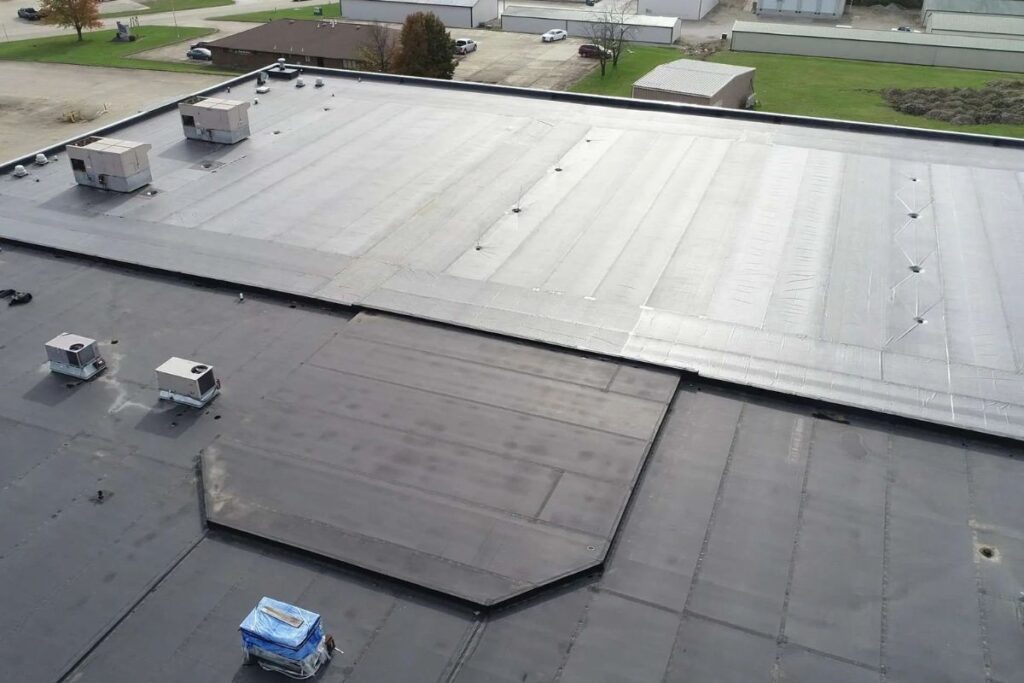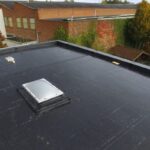Hello Friends, When building or renovating a commercial property, your choice of roofing material can make a big difference in cost, durability, and longevity. One roofing material that often tops the list for commercial use is EPDM (ethylene propylene diene monomer), also known as rubber roofing.
In this article, we’ll explore why EPDM is highly favored by both property owners and contractors. We’ll compare it with other single-ply membranes, outline its advantages and limitations, and help you understand if it’s the best option for your commercial building.
Why EPDM Is Often the Go-To Commercial Roof
1. Extremely Affordable
-
EPDM costs around $0.40 per square foot, a fraction of what other single-ply membranes like TPO or PVC cost.
-
For a typical commercial roof, this can mean savings of tens of thousands of dollars on materials alone.
2. Long Lifespan
-
Most manufacturers rate EPDM roofs to last 20–30 years, with many lasting 40+ with good installation and maintenance.
-
Contractors agree that under ideal conditions, a rubber roof can serve reliably for over 50 years.
3. Durability & Weather Resistance
-
EPDM meets standards such as ASTM D4637, ensuring resistance to hail, fire, UV radiation, and temperature shifts.
-
Reinforced EPDM (with slate or sawdust) is especially strong against hail and wind damage.
4. Exceptional Insulation
-
Flat commercial buildings need strong roofing insulation to maintain indoor temperature and reduce HVAC load.
-
EPDM’s rubber composition helps seal out moisture and insulate the building effectively.
5. Simple, Fast Installation
-
Contractors can install EPDM in just a few days using standard adhesives, reducing labor time and cost.
-
Quick installation also limits weather exposure during the roofing process.
6. Low Maintenance Requirements
-
Once installed correctly, EPDM requires minimal upkeep.
-
Routine inspections and minor repairs cost far less compared to other roofing types.
Flat Roof Systems for Commercial Buildings ( Complete Guide)
Other Roofing Options for Commercial Properties
| Roof Type | Lifespan | Cost per sq ft | Advantages | Disadvantages |
|---|---|---|---|---|
| EPDM | 20–30 yrs (40+ possible) | $0.40 | Affordable, quick to install, durable, watertight | Black surface absorbs heat (though white options exist) |
| TPO | 20–30 yrs | $4–7 | Reflective white surface, energy-efficient | Variable quality, seam welds may need maintenance |
| PVC | 30+ yrs | $8–10 | Chemical resistant, UV/storm/fire resistant | Expensive; not compatible with asphalt |
| Commercial/Architectural Shingles | 25–30 yrs | $5+ | Good curb appeal, steep-slope fit | High cost; used only for sloped sections |
| Metal | 30–50 yrs | $15–60 | Fire-resistant, light, long-lasting | Very costly, can be noisy |
| Asphalt Decks | 50+ yrs | $10+ | Supports green roofs, heavy foot traffic | Heavy weight; expensive structure support needed |
EPDM vs. Other Flat Roofing Membranes
EPDM (Rubber Roofing)
Contractors love EPDM for its simplicity, low cost, and performance. It offers:
-
Excellent resistance to water and weathering
-
Easy seam installation
-
Compatibility with various insulation methods
-
Fire-retardant formulations
TPO (Thermoplastic Polyolefin)
Pros:
-
Reflects sunlight, keeping buildings cool
-
Welded seams reduce leakage
Cons:
-
Quality varies; seams may weaken over time
-
Costs 10–15x more than EPDM
PVC (Polyvinyl Chloride)
Pros:
-
Strongest against chemicals and grease
-
Great for industrial or restaurant roofs
Cons:
-
Nearly 20x more expensive than EPDM
-
Incompatible with asphalt roofing systems
Advantages of EPDM for Commercial Roofing
Cost-Effectiveness
EPDM’s low cost per square foot allows building owners to allocate funds toward insulation, maintenance, or facility upgrades elsewhere.
Contractor-Friendly
-
EPDM installation requires minimal tools
-
With fewer components and faster setup, labor costs are reduced
-
Less time exposed means less risk of damage during installation
Weather Resilience
Tested standards ensure EPDM stands up to:
-
Hailstorms
-
UV radiation
-
Fire hazards
-
Thermal expansion and contraction
What You Should Know Before Installing EPDM
Choose Quality Product
EPDM membranes can vary by thickness and reinforcement. Choosing a reputable brand with hail-resistant or fire-retardant options adds long-term value.
Ensure Proper Installation
Even EPDM needs good workmanship:
-
Clean, dry roof deck
-
Proper edge flashing and adhesives
-
Inspections for secure seams and corners
Explore Color Options
White or light-colored EPDM is available and helps reflect heat—ideal for solar efficiency in warm climates.
Inspect Regularly
Routine checks catch damage before it worsens:
-
Inspect after storms
-
Look for punctures, seam peeling, or bulges
-
Clean and reseal damaged areas promptly
Is EPDM Right for Your Building?
Best Uses for EPDM Roofing:
-
Large flat roofs where cost savings matter
-
Projects needing fast installation and minimal upkeep
-
Buildings requiring strong weather and UV protection
Consider Alternatives When:
-
Heat reflection is top priority (TPO may be better)
-
Chemical resistance is required (PVC may be best)
-
You need long-term investment with high-end performance (metal or asphalt deck)
Real-World EPDM Performance
Here’s how EPDM holds up compared to other materials:
| Feature | EPDM | TPO | PVC | Metal |
|---|---|---|---|---|
| Initial Cost | $0.40/sq ft | $4–7 | $8–10 | $15–60 |
| Typical Lifespan | 20–30 yrs (up to 40+) | 20–30 yrs | 30+ yrs | 30–50 yrs |
| Installation Time | 2–5 days | 3–7 days | 4–8 days | 7–14+ days |
| Repairs Needed | Low | Moderate | Low | Low–Moderate |
| UV Resistance | Good | Excellent | Excellent | Excellent |
| Fire Protection | Good | Good | Excellent | Excellent |
| Reflectivity | Poor (black) | Excellent | Good | Good |
Is EPDM for You?
| Question | Answer for EPDM |
|---|---|
| Budget-friendly? | ✅ Very affordable |
| Lasts decades? | ✅ 20–30 yrs, even more |
| Easy to install? | ✅ Fast and simple |
| Withstands weather? | ✅ Yes – hail, UV, fire |
| Needs frequent repairs? | ⚠️ Minimal |
| Suitable for visible roofs? | ⚠️ Limited curb appeal |
| Best suited for hot climates? | ⚠️ Black absorbs heat |
For most commercial properties, EPDM rubber roofing is a smart, cost-effective choice. It offers:
-
Long-lasting protection
-
Quick, efficient installation
-
Weather, fire, and hail resistance
-
Low maintenance needs
If you need a flat roof that balances durability, insulation, and affordability, EPDM checks all the boxes. However, if specific factors like heat reflection or chemical resistance are important, you may want to explore TPO, PVC, or metal roofing.
Consult a licensed roofing contractor to assess your building’s needs and climate. With the right material and installation, your commercial roof can offer dependable protection and value for many decades.


